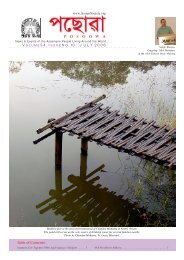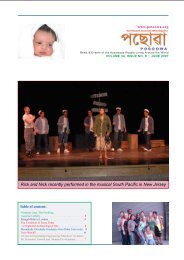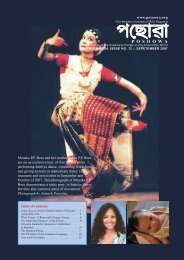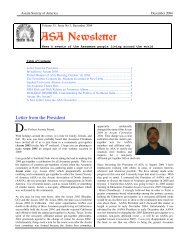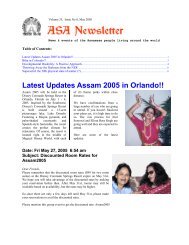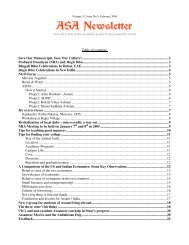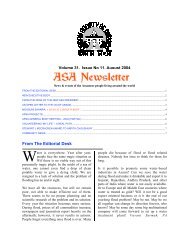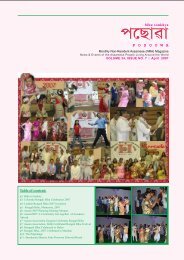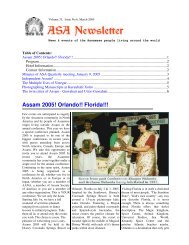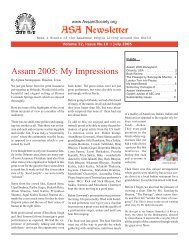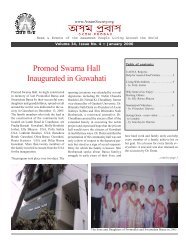You also want an ePaper? Increase the reach of your titles
YUMPU automatically turns print PDFs into web optimized ePapers that Google loves.
www.<strong>Assam</strong>Society.org<br />
News & Events of the <strong>Assam</strong>ese People Living Around the World<br />
Volume 34, Issue No. 1 :: Oc<strong>to</strong>ber 2005<br />
Inside ...<br />
<strong>Nitin</strong> <strong>Laid</strong> <strong>to</strong> <strong>Rest</strong><br />
with Military Honors<br />
I am back from my overnight trip <strong>to</strong> Hous<strong>to</strong>n<br />
<strong>to</strong> attend the funeral of our very own<br />
Ram and Alpana Sarngapani's son, <strong>Nitin</strong>.<br />
It was a somber, poignant but dignified event<br />
attended by many of <strong>Nitin</strong>'s and the<br />
Sarangapanis' friends and relatives and wellwishers.<br />
<strong>Nitin</strong> was laid <strong>to</strong> rest by an U S<br />
Marine contingent with full military honors.<br />
Some of the most <strong>to</strong>uching moments were:<br />
* <strong>Nitin</strong>'s friend Luis, a fellow marine who<br />
has just returned from Iraq and at whose<br />
house <strong>Nitin</strong> was celebrating his 24th birthday<br />
in the hours before his life was taken,<br />
pinning his combat ribbon on <strong>Nitin</strong>'s<br />
lapel. <strong>Nitin</strong> wished <strong>to</strong> go <strong>to</strong> Iraq and earn<br />
his own, but did not in deference <strong>to</strong> his parents'<br />
concerns. Luis explained over his<br />
cracked voice how he <strong>to</strong>ld <strong>Nitin</strong> <strong>to</strong> forget<br />
it, that it 'was not worth it'. But he unders<strong>to</strong>od<br />
how <strong>Nitin</strong>, a gentle and kind young<br />
man of average built, felt, how he was transformed<br />
by 9-11, and gave his own ribbon <strong>to</strong><br />
<strong>Nitin</strong> as his parting gift.<br />
* Reema Das' poignant rendition of <strong>Nitin</strong>'s<br />
favorite <strong>Assam</strong>ese lullaby: "Amaare' moina<br />
Promoting Specialty <strong>Assam</strong>ese Teas..........2<br />
A Legend’s Nite – Musical Journey<br />
from Brahmaputra <strong>to</strong> Mississippi..............3<br />
Eternal <strong>Assam</strong>ese Songs...........................4<br />
And QuietFlows the Luit..........................6<br />
India’s GDP needs <strong>to</strong> be four<br />
times and <strong>Assam</strong>’s GDP seven<br />
times – for Good School Education...7<br />
xuboye'---", reworded <strong>to</strong> "Amaare' <strong>Nitin</strong><br />
xuboye' --- ---" that choked up all who unders<strong>to</strong>od<br />
the lyrics. Reema explained <strong>to</strong> me<br />
how the night before the funeral, <strong>Nitin</strong>'s<br />
older friend Raja Deka came up with the<br />
idea and how she agreed <strong>to</strong> sing.<br />
* Folding of the stars and stripes that<br />
wrapped the casket by the marine officers<br />
and their handing it over <strong>to</strong> Alpnana and<br />
Ram.<br />
I did not know <strong>Nitin</strong> much, even though I<br />
met him a couple of times. But knowing<br />
Alpana and Ram as we do, <strong>Nitin</strong>, just like<br />
Caeser and An<strong>to</strong>ny (their two German Shepherds),<br />
who have become parts of our <strong>Assam</strong><br />
net family, it was not an easy thing <strong>to</strong> deal<br />
with. We hope Ram and Alpana will find<br />
the peace and the strength <strong>to</strong> carry on and<br />
re-orient their own lives <strong>to</strong> give meaning <strong>to</strong><br />
<strong>Nitin</strong>'s very short one.<br />
- Chandan Mahanta, St. Louis, Oc<strong>to</strong>ber 3,<br />
2005
<strong>Assam</strong> Society of America :: Oc<strong>to</strong>ber 2005<br />
Promoting Specialty <strong>Assam</strong>ese Teas<br />
There are few places that are as desolate<br />
and beautiful as a tea garden in the heart of<br />
Upper <strong>Assam</strong>. Hundreds of thousands of tea<br />
bushes on every side and the nearest <strong>to</strong>wn<br />
fifteen kilometers away, yet even a city boy<br />
growing up in these surroundings didn’t<br />
have much time <strong>to</strong> miss his city. His most<br />
favorite pastimes were fishing with his<br />
boroxi or jakoi, or heading out in<strong>to</strong> the Buri-<br />
Dihing jungles on foot, with his dah<br />
and his twenty-two bore Bruno<br />
rifle.<br />
world of tea that’s the heart of the <strong>Assam</strong>ese<br />
economy. They harvest over 200 varieties<br />
of black teas every year, making <strong>Assam</strong>ese<br />
tea the number one selection worldwide for<br />
the highest quality black teas. Commercially,<br />
black teas are harvested and processed<br />
in two traditional styles in <strong>Assam</strong> –<br />
either leaf teas or granular teas. Their tea<br />
gardens (Satrupa and Rani) are 100% leaf<br />
America average about three <strong>to</strong> four years<br />
of age.<br />
The biggest challenge of selling pure quality<br />
<strong>Assam</strong>ese teas in North America is ignorance.<br />
As people concerned educate<br />
North American tea buyers and marketers<br />
on the profile and taste characters of<br />
<strong>Assam</strong>ese teas, they start seeing the light<br />
behind how they can make a bundle by marketing<br />
specialty <strong>Assam</strong>ese teas in the fastest<br />
growing tea market in the world (i.e.,<br />
North America). They start figuring out how<br />
<strong>to</strong> get rid of their stash of decade old <strong>Assam</strong><br />
blends, and replacing them with a wide<br />
His father owns two tea gardens,<br />
Satrupa (aka Konapothar) Tea Estate<br />
in Tinsukia district, and Rani<br />
Tea Estate in Kamrup district. He<br />
has a knack for working on details,<br />
maybe, because of his training as a<br />
mechanical engineer, and <strong>to</strong>day his<br />
<strong>Assam</strong>ese teas are considered <strong>to</strong> be<br />
amongst the best (if not the best) of<br />
teas being harvested in <strong>Assam</strong>. His<br />
farming interest also extends in<strong>to</strong><br />
fisheries, goat farming, and a diary<br />
farm. He has the distinction of owning<br />
the only operational hydroelectric<br />
power plant in northeast India.<br />
His North American subsidiary,<br />
<strong>Assam</strong> Tea Company, was incorporated<br />
in 2000 and till date they have<br />
been marketing teas through three<br />
channels. The bulk of the teas are<br />
sold <strong>to</strong> importers, branders and gift product<br />
manufacturers who buy in larger volume<br />
(an average of 10,000 pounds per order).<br />
The smallest segment, but with the<br />
largest potential market, is their online retail<br />
s<strong>to</strong>re (www.assamtea.biz). Through this<br />
e-s<strong>to</strong>re they offer the largest selection of<br />
single malt (un-blended) specialty<br />
<strong>Assam</strong>ese teas <strong>to</strong> consumers in US &<br />
Canada. The last segment of their cus<strong>to</strong>mers<br />
is retailers with one or more retail outlets.<br />
These are usually tea bars, teashops,<br />
cafés, restaurants and gift shops. They also<br />
have quite a few social clubs that are part<br />
of this last segment of cus<strong>to</strong>mers.<br />
Most <strong>Assam</strong>ese people don’t know much<br />
about the very interesting and complex<br />
tea manufacturers. However, most <strong>Assam</strong><br />
tea gardens are predominantly granular tea<br />
manufacturers. The European, and North<br />
American marketplaces prefer leaf style<br />
teas.<br />
Even through since the 1850s, <strong>Assam</strong>ese<br />
black tea has been the backbone of the British<br />
tea industry, one will be surprised <strong>to</strong> find<br />
that very few tea drinkers in the Western<br />
world know their <strong>Assam</strong>s from their Earl<br />
Grays. Also the fact that there are very<br />
cheap black teas available from a number<br />
of other countries worldwide, many tea<br />
importers blend (mix) a tiny bit of <strong>Assam</strong>ese<br />
teas with teas from Sri Lanka, Vietnam,<br />
Kenya, Argentina or China, and call them<br />
Scottish Breakfast, Irish Breakfast, etc.<br />
Most of the <strong>Assam</strong>ese teas in North<br />
range of incredible tasting single malt<br />
<strong>Assam</strong>ese teas. Finally, American consumers<br />
are starting <strong>to</strong> get the choice of whether<br />
<strong>to</strong> drink thick, malty, autumnal harvest,<br />
single malt from Satrupa or a thin, tart, complex<br />
body, wet-ending Lower <strong>Assam</strong> tea,<br />
from Rani Tea Estate. I had the opportunity<br />
<strong>to</strong> taste myself during my visit <strong>to</strong> this establishment<br />
at St. Petersburg in Florida.<br />
Saunam Bhattacharjee is doing a tremendous<br />
job in marketing <strong>Assam</strong>ese tea bringing<br />
directly from the tea gardens in <strong>Assam</strong><br />
<strong>to</strong> the cups in North America. The pho<strong>to</strong><br />
shows him in his warehouse where he is<br />
expecting another container.<br />
- Ganesh Bora, Lake Alfred, Florida<br />
2
<strong>Assam</strong> Society of America :: Oc<strong>to</strong>ber 2005<br />
A Legend’s Nite – Musical Journey from<br />
Brahmaputra <strong>to</strong> Mississippi<br />
<strong>Assam</strong> Association, Delhi, organized a cultural<br />
evening “A Legend’s Nite – Musical<br />
Journey from Brahmaputra <strong>to</strong> Mississippi”<br />
by the legendary masestro Dr. Bhupen<br />
Hazarika on 16 Oc<strong>to</strong>ber 2005 in Siri Fort<br />
Audi<strong>to</strong>rium, Delhi. The proceeds of the<br />
cultural evening would be used for the construction<br />
of a cultural and educational center<br />
named after the revered Srimanta<br />
Sankaradev in Qutab Institutional Area. The<br />
contributions of that great genius <strong>to</strong> the literature,<br />
culture and society<br />
of <strong>Assam</strong> and its share in the<br />
pan-Indian identity and the<br />
Mahapurusha’s preaching of<br />
human dignity, an attitude of<br />
devotion <strong>to</strong> the Almighty and<br />
an un-acquisitive material<br />
pursuit in life is still relevant<br />
in <strong>to</strong>day’s life of high-tech<br />
glitz and at times confused<br />
interpersonal relations. That<br />
Dr. Bhupen Hazarika helped<br />
the Association in its effort<br />
by kindly consenting <strong>to</strong> hold<br />
a musical evening with some<br />
of his timeless numbers after<br />
many years in Delhi is<br />
also an indica<strong>to</strong>r of the continuum<br />
of the tradition<br />
Sankaradeva set.<br />
The proposed cultural and<br />
educational Centre would<br />
create a nurturing environment that would<br />
strengthen the sense of belonging, pride and<br />
appreciation of <strong>Assam</strong>ese cultural, heritage<br />
and his<strong>to</strong>ry. By organizing a great cultural<br />
show, <strong>Assam</strong> association, Delhi, realized its<br />
long cherished dream of having a cultural<br />
complex of its own.<br />
The event was sponsored by ONGC and Oil<br />
India. GAIL, HAL NEEPCO were the cosponsors<br />
while Indian Airlines was the<br />
travel partners. Smt. Julie Dutta, wife of<br />
Shri RK Dutta, CMD, OIL, was the Chief<br />
Guest. Noted filmmaker Kallpana Lajmi<br />
ably anchored the musical journey which<br />
was attended by over 1,500 people.<br />
Dr. Bhupen Hazarika, the multifaceted genius<br />
has been hailed as the cultural ambassador<br />
of <strong>Assam</strong> <strong>to</strong> the rest of the world. He<br />
is one of the stalwarts of Indian music <strong>to</strong>day.<br />
There are many facets <strong>to</strong> Bhupen<br />
Hazarika’s personality –singer, lyricist,<br />
musician, writer, filmmaker and a social<br />
crusader through his songs. Bhupenda’s<br />
name itself is musical for the people of eastern<br />
India; his Dil Hum Hum Kare won the<br />
hearts of millions of Indians.<br />
Dr. Bhupen Hazarika was born in the year<br />
1926. After his schooling in Tezpur and<br />
collegiate education in Guwahati, he<br />
receieved an MA Degree from Banaras<br />
Hindu University. Then he left for the Columbia<br />
University, New York where he received<br />
his doc<strong>to</strong>rate in Mass Communication.<br />
He also received the Lisle Fellowship<br />
from the Chicago University. It was during<br />
this period that he was awarded a gold medallion<br />
in NewYork as the best interpreter<br />
of India’s folk songs by Eleanor Roosevelt.<br />
He met Paul Robeson, the legendry black<br />
singer in the USA and was greatly influenced<br />
by his idea that “music is an instrument<br />
of social change”. On his return <strong>to</strong><br />
his homeland, he joined the Gauhati University<br />
as a lecture and went abroad in a<br />
cultural exchange program where he overstayed<br />
by a few days. The bold Bhupen tendered<br />
his resignation when some disciplinary<br />
action was initiated against him. He decided<br />
<strong>to</strong> take music as a livelihood and<br />
thereafter never looked back. He has been<br />
awarded the Padmashree (1977),<br />
Padmabhushan (2001), and Dadasaheb<br />
Phalke Award the highest honour for cinematic<br />
achievement, for his Lifetime Contribution<br />
Indian cinema in 1993. With his<br />
multifarious talent Bhupen hazarika has<br />
proved himself as a thoughtful writer by<br />
writing fifteen books on various subjects<br />
such as fiction, travelogues, essays and an<br />
au<strong>to</strong>biography.<br />
Manoj Kumar Das<br />
General Secretary<br />
<strong>Assam</strong> Association Delhi<br />
3
Eternal <strong>Assam</strong>ese Songs<br />
Hello <strong>Assam</strong>ese Reader! Here's a message<br />
from one of my friends, who works with<br />
UNI in Guwahati. Please send your lists<br />
<strong>to</strong> mrinalt@rediffmail.com. Also please<br />
drop a copy at <strong>Assam</strong>Net so that we all<br />
can learn about the best songs in<br />
<strong>Assam</strong>ese:<br />
Dear Friends<br />
The National Games 2005 is preparing an<br />
audio CD pf 12 Greatest <strong>Assam</strong>ese songs<br />
<strong>to</strong> be released along with its souvenier.I<br />
am taking this opportunity <strong>to</strong> invite you<br />
all <strong>to</strong> suggest the names of the 12 Gems of<br />
the <strong>Assam</strong>ese Songs.<br />
Mrinal Talukdar<br />
National Games Souveneier Committee<br />
Guwahati<br />
Of course, the lists will depend on personal<br />
choices and will widely vary, but I<br />
am sure all will agree on at least a few<br />
gems. Here's my own personal choice:<br />
1.Srimoyee Asomir (Puroshottam Das)<br />
2. O Mor Aponar Dex (Lakshminath<br />
Bezbaruah)<br />
3. Biswabijoyee Najowan (Jyotiprasad)<br />
4. Seuji Seuji (Jyotiprasad)<br />
5. Pujo Aha Aai Matrir (Parvatiprasad)<br />
6.Sagar Sangamat (Bhupen Hazarika)<br />
7. Moi Eti Jajabar ( -do-)<br />
8. Manuhe Manuhar Baabe ( -do-)<br />
9. Ma Aami Xodiyale Jaame (Khagen<br />
Mahanta)<br />
10. Majulit Ejoni Sowaliye Dukh Paale<br />
(Zubeen Garg, being a modern heartthrob)<br />
or Sal Gori (Krishnmani Sutia, one of the<br />
biggest hits in <strong>Assam</strong> ever, which has immensely<br />
popular in Bengal, Bihar, Nepal<br />
and even Bangladesh. It is a Jhumur song)<br />
11. Hastir Kanya (Pratima Pandey-Bhupen<br />
Hazarika)<br />
12. Xurore Deulore or O Axomiya Deka<br />
Dal (Bishnu Rabha)<br />
While this is my personal list, I feel there<br />
could be inclusion of a few songs from<br />
other languages from <strong>Assam</strong> (most notably<br />
Bodo or Karbi).<br />
- Utpal Borpujari, New Delhi<br />
by Dilip Datta, Univ of Rhode Island<br />
The difficulty of selecting good songs is <strong>to</strong><br />
decide the criteria for selection. So far, I am<br />
set on judging a song by each of the following<br />
components:<br />
1. Lyrics (Theme or richness of thought,<br />
sweetness of the words used, and literary<br />
style)<br />
2. Music (Synthesis of the tunes of the soil,<br />
tunes of the present day world, classical raag<br />
or raagini etc.)<br />
3. Dexterity of the singer <strong>to</strong> carry the feelings<br />
and emotions of<br />
the lyricist.<br />
4. Popularity.<br />
Of course, when making<br />
a selection, one<br />
ought <strong>to</strong> think of variety<br />
in each category.<br />
If you are thinking<br />
about 12 greatest<br />
<strong>Assam</strong>ese songs, you<br />
cannot ignore<br />
Sankardev and<br />
Madhabdev. I will definitely start with the<br />
following list:<br />
1. Suno, suno re suno boiry promana<br />
(Theme: Warning <strong>to</strong> evil doers; Lyrics:<br />
Sankardev; Music: Sankardev; Artist:<br />
Bhupen Hazarika)<br />
2. Burha bhai hori guna gai nacha<br />
(Theme: A humorous but relistic description<br />
of old age and how one can enjoy it; Lyrics:<br />
Madhabdev; Music: Madhabdev; Artist:<br />
Soda Gogoi)<br />
3. Boikuntha prokasr hori namo rawse<br />
(Theme: A supreme expression of gratitude<br />
and soul stirring appreciation of what<br />
Sankardev has done for <strong>Assam</strong>; Lyrics:<br />
Madhabdev; Music: Madhabdev; Artist:<br />
Soda Gogoi)<br />
4. Aaji jaagaa moor matri (Theme: A song<br />
that brings out the patriotic sentiment prevailing<br />
in the early part of the twentieth century;<br />
Lyrics: Jyotiprosad Aggarwala; Music:<br />
Jyotiprosad Aggarwala; Artist: Pulak<br />
Bannerjee)<br />
5. Aami kori phuroon biakul (Theme:A<br />
soul's longing <strong>to</strong> be one with nature; Lyrics:<br />
<strong>Assam</strong> Society of America :: Oc<strong>to</strong>ber 2005<br />
Jyotiprosad Aggarwala; Music: Jyotiprosad<br />
Aggarwala; Artist: Zubeen Garg and<br />
Nitumoni Bora)<br />
6. Diyaa jodi dekha aai (Theme: A true<br />
lover's moment of realization when he sees<br />
his lover as his goddess: Lyrics: Ganesh<br />
Gogoi; Music: Chandra kamal; Artist:<br />
Monisha Hazarika)<br />
7. Tumi Nusuna ganor sunala amiyaa sur<br />
(Theme: An appreciation of what love brings<br />
<strong>to</strong> one; Lyrics: Anandi Das; Music: Anandi<br />
Das; Artist: Nirmal Chakravarty)<br />
8. Nahor phule nusuwai (Theme: A strong<br />
resolve of a lover <strong>to</strong> give the best of everything<br />
<strong>to</strong> his lover; Lyrics: Bishnu Prosad<br />
Rabha; Music: Bishnu Prosad Rabha; Artist:<br />
Bhupen Hazarika and Pompa Gogoi)<br />
9. Logan ukoli goal (Theme: A soul's resolve<br />
<strong>to</strong> cope with tragedy; Lyrics: Bishnu<br />
Prosad Rabha; Music:<br />
Bishnu Prosad Rabha;<br />
Artist: Kamal<br />
Chowdhury)<br />
10. Aakaasor paar<br />
bhaangi naami aahe<br />
junakor dhol (Theme: A<br />
description of the<br />
heartthrobbing experience<br />
on a moonlit night;<br />
Lyrics: Ajit Barua; Music:<br />
Brojen Barua; Artist:<br />
Monojyotsna Goswami)<br />
11. Nibir bone je matise<br />
ja (Theme: A soul's yearning <strong>to</strong> be one with<br />
nature; Lyrics: Nirmalprova Bordoloi; Music:<br />
Jayanta Hazarika; Artist: Jayanta<br />
Hazarika)<br />
12. Kasot kolochi haali jaali koon menoka<br />
aahe (Theme: Rhythmic description of a<br />
rural damsel, a bongeet; Lyrics: Rudra<br />
Barua; Music: Rudra Barua; Artist: Gyanada<br />
Kakoti)<br />
13. Sou kuonwolir aarot sunaali (Theme:<br />
The joy and thrill that fills one's heart during<br />
the harvesting season; Lyrics:<br />
Nirmalprova Bordoloi; Music: Mukul Barua<br />
; Artist: Parveen Sultaana)<br />
14. Snehe aamaar Sota srabanot (Theme:<br />
Friendship and its assurances; Lyrics:<br />
Bhupen Hazarika; Music: Bhupen Hazarika;<br />
Artist: Bhupen Hazarika)<br />
15. Jilir maate gobhir kore nirjonota<br />
(Theme: Love for mother and one's culture;<br />
Lyrics: Nabakanta Barua; Music: Biren<br />
Datta, Artist: Biren Datta)<br />
16. Kauri pore (Theme: A great song about<br />
the pangs of separation felt by a loving man<br />
whom the realities of the society has sepacontd.<br />
<strong>to</strong> page 5...<br />
4
ated from his wife and daughter; Lyrics:<br />
Keshab Mahanta; Music: Rudra Barua; Artist:<br />
Khagen Mahanta)<br />
17. Imaan dhuniya mukutaar maalaa<br />
(Theme: (can't describe it well, please try<br />
and tell me) ; Lyrics: Molin Bora; Music:<br />
Ikramul Mazid & Durga Bhuyan; Artist:<br />
Torikuddin Ahmed)<br />
18. Eai Niribili Jonowaali Godhuli mon<br />
moor herai jai <strong>to</strong>omak nisai kasote pai<br />
(Theme: The bliss that one finds when the<br />
dearest is sitting beside; Lyrics: Himadri<br />
Devi; Music: Jyoti Chakravarty; Artist:<br />
Durgamoyee Bora)<br />
19. Senai moi Jaoon (Theme: A lover's<br />
words of consolation <strong>to</strong> his lover before he<br />
sets sails for a land far away and that <strong>to</strong>o<br />
for a very long time. Even though the sentiment<br />
borders on selfishness, this sweet song<br />
remains one of the most popular songs till<br />
this day; Lyrics: Komal Hazarika; Music:<br />
Komal Hazarika; Artist: Deepaali<br />
Barthakur)<br />
20. Najaabaa Naajaaba mooke eri thoi<br />
(Theme; A lover sincerely urges his lover<br />
not <strong>to</strong> leave him (perhaps for another man).<br />
This simplistic expression of a far <strong>to</strong>o common<br />
experience of a bachelor (who does not<br />
have the courage <strong>to</strong> get married) set on Bihu<br />
tune was a super hit of the twentieth century;<br />
Lyrics: Kumar Bhabesh; Music:<br />
Kumar Bhabesh; Artist: Kumar Bhabesh)<br />
21. Chol Guri (Theme: A determined lover's<br />
resolve not <strong>to</strong> part with his lover but <strong>to</strong> take<br />
her with him and make her his wife in a respectable<br />
way by convincing his parents and<br />
society <strong>to</strong> accept her. Compared <strong>to</strong> the lover<br />
in 'Najaaba najaaba', this lover has guts, and<br />
compared <strong>to</strong> the lover in 'Senai moi jaon',<br />
this lover does not appear <strong>to</strong> have self-serving<br />
designs.)<br />
22. Moor sutaalor tuloshi <strong>to</strong>lot (Theme: A<br />
mother-in-law's love for a dear departed<br />
daughter-in-law; Lyrics: Bhagagiri<br />
Roychoudbhury; Music: Jiten Deb; Artist:<br />
Nomita Bhattacharya)<br />
23. Mondacranta moor kobitaar koon<br />
tumi Madhuchanda (Theme: Perhaps an<br />
expression of faith in love, imagination,<br />
music as the inspiration for human creativity<br />
; Lyrics: Taffazul Ali; Music: Taffazul<br />
Ali; Artist: Jyotirmoy Kakoti)<br />
24. Eai maayaar dhorat (Theme: An ennobling<br />
sentiment of the time we live in;<br />
Lyrics: Zubeen Garg; Music: Zubeen Garg;<br />
Artist: Zubeen Garg)<br />
-This list was created by noted author<br />
Dilip Datta of Rhode Island in response<br />
<strong>to</strong> Utpal Borpujari’s request.<br />
And Quiet Flows the Don<br />
(contd from pg. 6..)<br />
tributes <strong>to</strong> both financial success and morale<br />
boost of the enterprise that produces it, which,<br />
in turn helps it <strong>to</strong> produce more. At <strong>Assam</strong> 2005,<br />
an <strong>Assam</strong>ese businessman even talked about<br />
buying the copyright of the film and, subsequently,<br />
having it telecast through popular<br />
American and international media. I would s<strong>to</strong>p<br />
short of giving any recommendations on this,<br />
but I think it’s definitely worth some consideration.<br />
5<br />
<strong>Assam</strong> Society of America :: Oc<strong>to</strong>ber 2005<br />
Some other areas that have great potential for<br />
this kind of documentary films are the national<br />
parks and the wildlife of the region. In addition<br />
<strong>to</strong> giving viewers a chance <strong>to</strong> unveil the mysteries<br />
of nature; these films can greatly augment<br />
the <strong>to</strong>urism industry of the region. Every time I<br />
watch a PBS or an IMAX film on Serengeti, the<br />
islands of Galapagos or the Amazon rainforest,<br />
I feel like visiting those places. With the widening<br />
bandwidth of the upper middle class in a<br />
country like India, a globalization super hub, I<br />
am sure people would love <strong>to</strong> explore the wildlife<br />
galore, unspoiled beauty and adventure traveling<br />
that the Northeast region of India has <strong>to</strong><br />
offer.<br />
In the end, I would like <strong>to</strong> congratulate Sanjoy<br />
Hazarika, Jahnu Barua and their crew members<br />
who came forward with such a brilliant idea on<br />
the Brahmaputra, one of the biggest but the least<br />
documented rivers in the world, and braved the<br />
rugged landscape of the region <strong>to</strong> turn it in<strong>to</strong> an<br />
informative and enjoyable film. I hope they will<br />
produce many more such films in the years <strong>to</strong><br />
come. I would like <strong>to</strong> wish them the very best<br />
for any such endeavors in the future. Partha<br />
Gogoi of Fairfax, Virginia is the North American<br />
contact for the movie. For your copy of the<br />
DVD on the film, you may contact Partha at<br />
partha_gogoi@hotmail.com.<br />
- by Prakash Deka, North Brunswick, New<br />
Jersey
During <strong>Assam</strong> 2005 in Orlando, Florida, I had<br />
the opportunity of viewing Sanjoy Hazarika’s<br />
documentary film “A river’s s<strong>to</strong>ry - the quest<br />
for the Brahmaputra”. This is the first full-length<br />
documentary film that I have ever seen on the<br />
mighty river that runs through the entire subcontinent<br />
of northeast India. Being brought up<br />
in Guwahati, I used <strong>to</strong> enjoy the river almost<br />
everyday - a river that runs through it. In my<br />
opinion Sanjoy Hazarika, Jahnu Barua and the<br />
other crew members have done an excellent job<br />
in providing with the much needed insight in<strong>to</strong><br />
this river along with the cultures and peoples<br />
that are so intricately intertwined with it, which<br />
many like me have always wondered. When I<br />
was a little kid, my family lived in a small <strong>to</strong>wn,<br />
called Biswanath Chariali, located on the north<br />
bank of the Brahmaputra. During school-breaks,<br />
we often visited our relatives’ place in Guwahati.<br />
During the journey when it was about time <strong>to</strong><br />
reach North Guwahati, I had all more good reason<br />
<strong>to</strong> occupy a window seat. I was whispered<br />
<strong>to</strong> by the surroundings – as if horses have begun<br />
<strong>to</strong> smell their stables – my dream river<br />
Brahmaputra was not <strong>to</strong>o far away. Everything<br />
about the river stirred the curiosity of my young<br />
mind and, it continues <strong>to</strong> do so even now - the<br />
seemingly endless silvery sheet of water caressed<br />
by the rolling hills from all around, the<br />
boats that dotted the river and sailed on westerly<br />
wind and, not a bit less was my wide-eyed<br />
wonderment of the Saraighat Bridge itself that<br />
connects the two banks of it – I still vividly remember<br />
I tried counting the number of support<br />
links on its structure every time we crossed the<br />
river, but only <strong>to</strong> mess-up my count in the last<br />
minute<br />
* Inspired by the name “And Quiet Flows<br />
the Don” – a novel by Mikhail Sholokhov<br />
often praised for its sweeping descriptions<br />
of nature.<br />
About the film:<br />
Picture: by the author<br />
Well, the above was only the tip of an iceberg<br />
of my never-ending attachment with the river.<br />
In the film, I was thrilled <strong>to</strong> see the origin of the<br />
Brahmaputra – a mammoth glacier-mass located<br />
in the northernmost chain of Himalayas and not<br />
very far from the lake Mansarowar. Then it<br />
comes roaring down the labyrinthine mountain<br />
ranges through some of the world’s deepest and<br />
steepest gorges – a lavish display of the power<br />
and mystery of nature. The river, gathering<br />
momentum with every inch of advancement<br />
along its course, works as an elixir for human<br />
civilizations and cultures <strong>to</strong> flourish on either<br />
bank of it. The clusters of timeless villages concealed<br />
in the folds of dramatic escarpment, the<br />
serenity of the deep-rooted spirituality of Buddhism<br />
as mystic as the solitude of the river itself,<br />
the legend of the Tibetan monastery and<br />
the kaleidoscopic arrays of Tibetan tribes and<br />
folk-dancers are all breathtaking <strong>to</strong> watch.<br />
A relentless river that the Brahmaputra is – it<br />
keeps flowing - down <strong>to</strong> <strong>Assam</strong> after artfully<br />
scarring the unspoiled landscape of Arunachal<br />
6<br />
<strong>Assam</strong> Society of America :: Oc<strong>to</strong>ber 2005<br />
Pradesh, a heavenly abode where time appears<br />
<strong>to</strong> stand still! The life and culture of the world’s<br />
largest river island, Majuli, as very accurately<br />
depicted in the film, are simply fascinating <strong>to</strong><br />
watch. One can trace the footsteps of the last of<br />
the <strong>Assam</strong>ese legends, Mahapurux Srimanta<br />
Sankardev, in every walk of life on this river<br />
island.<br />
Time fades, becomes past, but the legendary<br />
river keeps flowing – it whispers of Usha and<br />
Aniruddha and their the epic of love on its way<br />
near Tezpur. The potent river provides the<br />
lifeblood of various industries on its banks, like<br />
the ones based on golden cocoons in Sualkuchi<br />
and the metal works in Barpeta.<br />
I have seen only in the pictures before, but it<br />
was a learning-experience for me <strong>to</strong> see the life<br />
and culture surrounding the Bangladesh side the<br />
river Brahmaputra, known as Padda. The sonority<br />
of the “bhatiali geets” as a long day begins<br />
<strong>to</strong> fold itself in<strong>to</strong> twilight endorses the inseparable<br />
bonding between a river and the humans<br />
from the time immemorial.<br />
Some comments:<br />
In the absolute sense, there is certainly some<br />
room for improvement in the picture quality<br />
as I assessed of the film. But I have <strong>to</strong> admit<br />
at the same time that it will be foolish <strong>to</strong><br />
expect, due <strong>to</strong> climatic differences, the same<br />
picture clarity as it is expected <strong>to</strong> come out of<br />
the herds of deer zooming in and out of the<br />
camera lenses in a flash in Serengeti or of<br />
Jackson lake embracing the cascades of Grand<br />
Te<strong>to</strong>n range, where even the wind seems <strong>to</strong><br />
shy away from putting the first ripple on! The<br />
industrial pollution and the chaining effects of<br />
deforestation in the countries like India often<br />
create smoggy conditions interfering with the<br />
clarity of pictures. Also, relatively better<br />
established enterprises have an edge over the<br />
growing ones as far as the affordability of the<br />
latest state-of-the-art equipment is concerned.<br />
When the film was first played and projected<br />
off of a computer at the conference, my first<br />
impression about the sound quality was that it<br />
could have been better. But before writing these<br />
comments, when I watched the film again on<br />
my computer with iPod headphones attached <strong>to</strong><br />
it, both And Quiet Flows the Don narration and<br />
sound quality appeared <strong>to</strong> be pretty good.<br />
On this era of globalization when the world<br />
seems <strong>to</strong> be shrinking everyday, it is needless <strong>to</strong><br />
reiterate the importance of exposure of any form<br />
of creativity <strong>to</strong> the international audience. It con-<br />
Contd. <strong>to</strong> page.5...
<strong>Assam</strong> Society of America :: Oc<strong>to</strong>ber 2005<br />
India’s GDP needs <strong>to</strong> be four times and <strong>Assam</strong>’s<br />
GDP seven times – for Good School Education<br />
For the past two days I had been pursuing an<br />
idea as <strong>to</strong> how much money is needed for providing<br />
“good” school education <strong>to</strong> ALL Indian<br />
students and how rich should India and <strong>Assam</strong><br />
be <strong>to</strong> afford it. The idea struck me that if I can<br />
extrapolate the figures for Jaipur School’s 500<br />
students — for the whole nation - it may be<br />
workable.<br />
Methodology & Result:<br />
It is believed that any economy should spend at<br />
least about 6% of its GDP on education . Every<br />
economy has limited resources so it is perhaps<br />
not possible for all economies <strong>to</strong> spend huge portions<br />
on everything. Thus, a figure of 6% of GDP<br />
has been arrived at by international consensus<br />
as a minimum requirement expenditure on education.<br />
USA spends 4.2 % of its GDP on school education<br />
and 2.6% on higher ed. In <strong>to</strong>tal USA spends<br />
about 6.8% of its GDP on education (http://<br />
nces.ed.gov/pubs98/98009.pdf).<br />
USSR used <strong>to</strong> spend 10% of its GDP on education<br />
but Russia now spends only 0.60% (http://<br />
www.unesco.org/education/efa/know_sharing/<br />
grassroots_s<strong>to</strong>ries/russia.shtml).<br />
India as a whole spends only 3.3% of its GDP<br />
on education. But even if it were <strong>to</strong> increase its<br />
spending <strong>to</strong> 6% of the GDP - will that be<br />
enough My calculations are <strong>to</strong> identify how<br />
much money needs <strong>to</strong> be spent <strong>to</strong> provide effective<br />
and efficient education <strong>to</strong> school kids in<br />
India and <strong>Assam</strong>. My calculations show that<br />
India needs <strong>to</strong> spend about $100 Billion on education,<br />
with $66 Billion of it on school education<br />
alone. India currently spends only $13 Billion<br />
on Education overall.<br />
So the question is how rich should India be - <strong>to</strong><br />
afford <strong>to</strong> have $100 Billion <strong>to</strong> spend on education<br />
- and not run short on other priorities. With<br />
the current GDP of India - a $100 Billion expenditure<br />
on Education would be equivalent <strong>to</strong><br />
about 22% of its GDP ($455 Billion).<br />
Thus, the question is what should be the GDP<br />
of India - <strong>to</strong> be able <strong>to</strong> spend $100 Billion — as<br />
only 6% of their GDP. India needs <strong>to</strong> have 4<br />
times its current GDP - i.e., $1700 Billion — <strong>to</strong><br />
be able <strong>to</strong> afford a $100 Billion Education expenditure.<br />
Similarly <strong>Assam</strong> needs <strong>to</strong> have 7 times<br />
its current State GDP <strong>to</strong> afford good quality<br />
school education for ALL school children.<br />
The hypothesis<br />
is<br />
that the<br />
Jaipur<br />
School in<br />
Jaipur,<br />
Rajasthan,<br />
India, is a<br />
well run<br />
school -<br />
providing<br />
effective<br />
and efficient<br />
education<br />
<strong>to</strong><br />
500 school<br />
kids from<br />
grades<br />
Kinder Garten <strong>to</strong> 12th grade - with specialization<br />
of Math, Computer Science, Biology,<br />
Chemistry, Physics, Economics, Business Studies,<br />
Accountancy, Sanskrit — in high school<br />
grades — besides the usual subjects for lower<br />
grades. The students and teachers are nearly all<br />
from middle level SES (Socio-Economic Status<br />
families).<br />
It has an optimal 9,000 sq. m. (2 acre) school<br />
campus , with a 25,000 sq. ft. built up area on<br />
four floors – with about 90% campus area as<br />
play grounds. Beside a near 100% pass rate (with<br />
atleast 95% students scoring first division) in<br />
the national exit exams (CBSE) in grade 10 and<br />
12 – much better than nearly all US public<br />
schools – there is provision for a variety of<br />
weekly extra curricular activities etc., for all<br />
round development. All students go on <strong>to</strong> 3 year<br />
or 4 or 5 year degree college. It is true that the<br />
school management may not be following ultra-modern<br />
teaching methodologies – but the<br />
overall effect of the school’s education is desirable.<br />
Now the calculations of their expenses per student,<br />
per year<br />
Given my personal experience with the school<br />
– I can say that the figures are not cooked up or<br />
expenses bloated<br />
Per month expenses – certified by the Chartered<br />
Accountant –figures as per year 2003-04<br />
(45 INR = 1.0 USD) are given in the accompanying<br />
table.<br />
Per Annum school expenses per school kid<br />
= $18 * 12 = $220 approx.<br />
NOW calculating expenses for schooling of<br />
ALL kids in India of relevant age (4 <strong>to</strong> 18)<br />
(Minimum school going age in India is 4<br />
years – as per Delhi Govt. directive)<br />
1. India’s population = 1 billion<br />
2. Below age 25 years = 50% = 500 million<br />
3. India’s population in Ages 4 <strong>to</strong> 18 = 30% =<br />
300 million<br />
4. Cost of educating one school kid per year =<br />
$220<br />
5. Cost of effectively and efficiently<br />
educating India’s 300 million School kids<br />
= $220 * 300 million<br />
= $ 66 BILLION!!<br />
(<strong>to</strong> be concluded in next issue)<br />
- Umesh Sharma, Cambridge, Massachusetts
This is an<br />
Official Publication of<br />
<strong>Assam</strong> Society of America, USA<br />
The ASA Newsletter is published monthly. Sanjib Bhuyan, NJ, on behalf of <strong>Assam</strong> Society of America, has published this issue of ASA newsletter.<br />
The edi<strong>to</strong>rs are Satyam Bhuyan (Ames, Iowa), Ganesh Bora (Lake Alfred, Florida), Prasenjit Chetia (Atlanta, Georgia), Babul Gogoi (New Delhi,<br />
India), Jugal Kalita (Colorado Springs, Colorado, Co-Edi<strong>to</strong>r-In-Chief), Vavani Sarmah (Secane, Pennsylvania), Rini Kakati (London, UK), Umesh<br />
Sharma (Cambridge, Massachusetts), Alpana Sarangapani (Co-Edi<strong>to</strong>r-In-Chief, Hous<strong>to</strong>n, Texas) and Ram Sarangapani (Hous<strong>to</strong>n, Texas). The<br />
ASA Executive Committee is composed of Sanjib Bhuyan, President (Franklin Park, New Jersey), Utpal Brahma, Vice President (Burling<strong>to</strong>n, New<br />
Jersey), Ganesh Bora, General Secretary (Lake Alfred, Florida), Probal Tabhildar (Kendall Park, New Jersey), Mantu Baishya (Omaha, Nebraska),<br />
Kedar Bhuyan (Mays Landing, New Jersey), and Sangeeta Duorah (California), Nandini Bora Das (Centennial, Colorado).<br />
We invite contribu<strong>to</strong>rs from all over the world. We appreciate your valuable feedback, comments & suggestions, and of course, news from your part<br />
of the world for inclusion in the coming editions. Please send your written contributions <strong>to</strong> asanewsletter@yahoo.com. If you prefer, you can send<br />
your contributions directly <strong>to</strong> any of the edi<strong>to</strong>rs listed above as well. Any contribution must be 750 words or shorter in length. Please include a<br />
scanned image of the author. We also request you <strong>to</strong> submit other pertinent pho<strong>to</strong>graphs if possible.<br />
<strong>Assam</strong> Society of America<br />
PO Box 254<br />
Mays Landing<br />
NJ 08330<br />
USA




